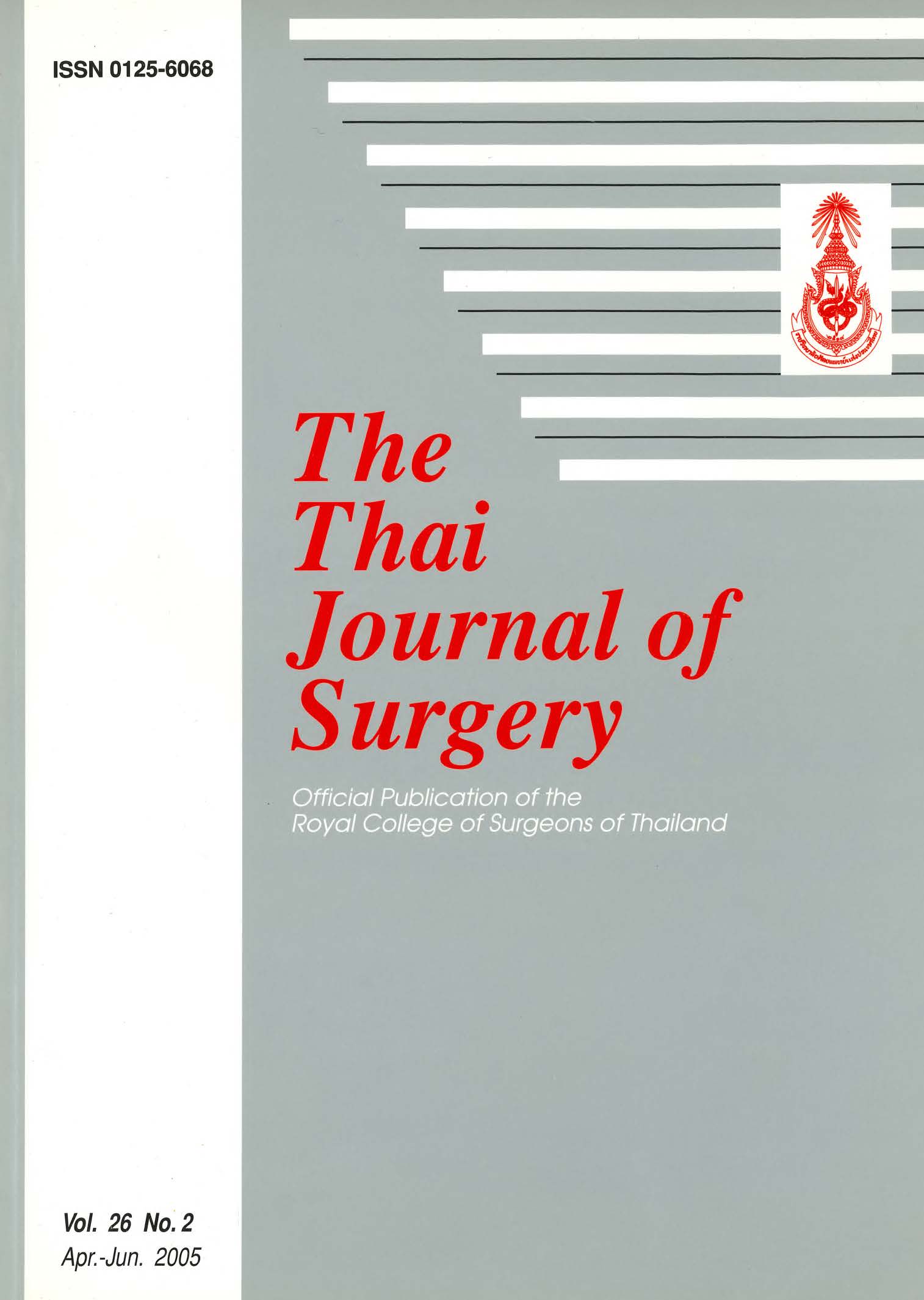Predicting Factors for Common Bile Duct Stones: How Significance is Significant ?
Abstract
Background: A widely adopted policy is to subject patients with cholelithiasis who is considered to be at risk for CBD stones to endoscopic retrograde cholangiography (ERCP). The criteria for ERCP were based on recognized clinical presentation, liver function test and abnormal sonographic finding. However, following such criteria, CBD stones are present in only 10-60% of patients thus unnecessary ERCP occurs in a significant number of such patients. ERCP is not a totally safe procedure. To avoid complications, patient with low risk may proceed to intraoperative cholangiography (IOC) instead of ERCP.
Objectives: To investigate the probable effective factors indicating the presence of CBD stone, thereby decreasing unnecessary ERCP.
Materials and Methods: Medical records of 220 patients at Police General Hospital with a diagnosis of acute or chronic cholecystitis or asymptomatic gallstone, between January 1992 and January 2002 were analyzed. Predictors of CBD stones were determined by univariate and multivariable analysis.
Results: Age, serum level of bilirubin, aspartate aminotransferase, alanine aminotransferase, alkaline phosphatase and the existence of jaundice, dilated bile duct, and pathologic gall bladder were found to be associated with CBD stones. Logistic regression was undertaken. Four factors were found to be significant; age (≥55 years) odds ratio 2.3; SGOT (over two fold normal) odds ratio 1.9; gallstone (multiple) odds ratio 6.8; and size of CBD (>10 mm) odds ratio 3.4.
Conclusions: A simple screening of patients at risk for CBDS can be achieved with four predictive criteria adapted for patients.
References
2. Davidson BR, Neoptolemos LP, Carr-Locke DL. Endoscopic sphincterotomy for common bile duct calculi in patients with gallbladder in situ considered unfit for surgery. Gut 1988: 29:114-20.
3. Lai ECS, Mok FPT, Tan ESY, et al. Endoscopic biliary drainage for severe acute cholangitis. N Engl J Med 1992; 326: 1582-6
4. Neoptolemos JP, London NJ, James D, Carr-Locke DL, Bailey IA, Fossard DP. Controlled trial of urgent endoscopic retrograde cholangiopancreatography and endoscopic sphincterotomy versus conservative treatment for acute pancreatitis due to gallstones. Lancet 1988; 2: 979-83.
5. Acosta JM, Ledesma CL. Gallstones migration as a course of pancreatitis. N Engl J Med 1984; 290: 484-7.
6. Abboud PA, Malet PE, Berlin JA, et al. Predictors of common bile duct stones prior to cholecystectomy: a meta-analysis. Gastrointest Endosc 1996; 44: 450-5.
7. Neoptolemos JP, London N, Bailey I, et al. The role of chemical and biochemical criteria and endoscopic retrograde cholangiopancreatography in the urgent diagnosis of common bile duct stones in acute pancreatitis. Surgery 1986; 100: 732-42.
8. Shively EH, Wieman TJ, Adams AL, et al. Operative cholangiography. Am J Surg 1990; 159: 380-4.
9. Koch H, Rosch W, Schaffner O, Demling L. Endoscopic papillotomy. Gastroenterology 1977: 73: 1393-6.
10. Nehaus B, Safrany L. Complication of endoscopic sphincterotomy and their treatment, Endoscopy 1981;13:197-9.
11. Geenen JE, Vennes JA, Silvis SE, Resume of a seminar on endoscopic retrograde sphincterotomy (ERS), Gastrointest Endosc 1981; 27: 31-8.
12. Escourrou J, Cordova JA, Lazorthes F, Frexinos J, Ribet A. Early and late complications after endoscopic sphincterotomy for biliary lithaisis with and without the gallbladder. Gut 1984;25:598-602.
13. Vaira D, Ainley C, Williams s, et al. Endoscopic sphincterotomy in 1000 consecutive patients. Lancet 1989; 2: 431-3.
14. Lambert ME, Betts CD, Hill J, Faragher EB, Martin DF, Tweedle DEF, Endoscopic sphincterotomy: the whole truth. Br J Surg 1988; 23: 594-6.
15. Cotton PB. Complications, comparisons and confusion; a commentary. In: Cotton PB, Tygat GNJ, Williams CB, editors. Annual of gastrointestinal endoscopy. London: Current science;1990.
16. Surick B, Washington M, Ghazi A. Endoscopic retrograde cholangiopancreatography in conjunction with laparoscopic cholecystectomy. Surg Endosc 1993; 7: 388-92.
17. Rijina H, Borgstein PJ, Meuwissen SGM, et al. Selective preoperative endoscopic retrograde cholangiopancreatography in laparoscopic biliary surgery. Br J Surg 1995; 82:1130-3.
18. Onken JE, Brazer SR, Aisen GM, et al. Predicting the presence of choledocholithiasis in patients with symptomatic cholelithiasis. Am J Gastroenterol 1996; 91: 762-7.
19. Reiss R, Deutsch AA, Nudelman I, Kott I. Statistical value of various clinical parameters in predicting the presence of choledochol stones. Surg Gynecol Obstet 1984;159: 273-6.
Downloads
Published
How to Cite
Issue
Section
License
Articles must be contributed solely to The Thai Journal of Surgery and when published become the property of the Royal College of Surgeons of Thailand. The Royal College of Surgeons of Thailand reserves copyright on all published materials and such materials may not be reproduced in any form without the written permission.



